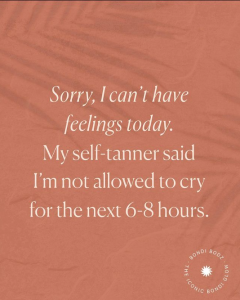Going from a natural tan, all stretched out under the warm sun, to relying on self-tanners is not a straight path. It is natural for people to want the best of both worlds. While we will answer the question posed as to whether it is okay to sun tan with a self-tanner on, we believe the more appropriate question is why. Read on.
Can I still lay out in the sun with a self-tanner on?
Ah, the million dollar question. Many have wondered if self-tanners hinder your ability to tan under the sun, and the answer is no. This will not drastically change your skin in any way. Both sun tanning and self-tanning change your skin colour, but they do so in varied ways. Typically, self-tanner use an ingredient called DHA, or dihydroxyaceton, which is an active ingredient. The amino acids in dead skin cells interact with the sugar-derived active ingredient on the outermost layer of your epidermis. The effect is a temporary bronzing of the skin that self-tanning enthusiasts have come to love.
This bronzing effect is also called the Maillard reaction. If you’re familiar with this term, it is the one you probably have heard of in baked goods – it gives off that golden colour (and yummy taste too). Don’t worry though, this doesn’t liken your skin to baking in an oven. Unless you’re actually baking under the sun. A clear difference between that two is that your glow fades as rapidly as your skin cells shed, whereas sun tanning or sun beds go through deeper layers of your skin.
You’re probably thinking, “Why would I go for self-tanning if it will just fade faster?” A painful sunburn comes from UVB rays, and UVA radiation stimulates cells called melanocytes to produce melanin. This does produce a longer lasting tan, but it also comes with numerous tradeoffs such as premature skin ageing, skin cancer, and various kinds of sun damage.
To circle back, using a self-tanner won’t hinder or alter your ability to tan naturally. However, it is a bazillion times safer than the former.
How is self-tanning safer though?
Great question. First of all, let’s get this clear: self-tanners won’t give you UV protection. It’s just not designed to protect you from the sun. Just because a great self-tanner feels good on your skin doesn’t mean it protects it. It contains no SPF and does not produce melanin. When using self-tanners, you still need to whip out your strongest SPF protection and lather it on like there’s no tomorrow. We recommend an SPF 30 or 50 especially if you plan to stay out in the sun for quite a while. The sunburn can get very real for the assuming self-tanner.
Despite its inability to defend your skin, self-tanners work more on the offensive side. This is where the question “why?” becomes more appropriate. Why would you want a tan from the sun if you can get one from a self-tanner without risking acquiring various skin diseases? Sure, enjoying the warmth of the sun is great, but if you don’t have to bake under it for hours on end to enjoy it, we suggest you think of your skin’s health on a longer term.
To conclude, tanning under the sun and self-tanning can go hand-in-hand, but sun tanning carries a lot more cons to it. We suggest doing it in moderation and let your sun-tanner handle the rest. You’ll have beautifully bronzed skin that gets even more nourished with each use.


